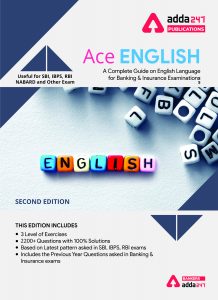Directions (1-5): Rearrange the following sentences in the proper sequence to form a meaningful paragraph. Then answer the questions given below them.
(A) With renewed confidence, she took a deep breath and continued.
(B) The speech she had prepared for weeks suddenly felt inadequate.
(C) She stood at the podium, looking out at the sea of faces.
(D) As a result, her nerves got the better of her, and she stumbled over her words.
(E) But then she remembered the reason why she was there.
Q1. Which of the following will be the third sentence after rearrangement?
(a) A
(b) B
(c) C
(d) D
(e) E
Q2. Which of the following will be the last sentence after rearrangement?
(a) A
(b) B
(c) C
(d) D
(e) E
Q3. Which of the following will be the second sentence after rearrangement?
(a) A
(b) B
(c) C
(d) D
(e) E
Q4. Which of the following will be the fourth sentence after rearrangement?
(a) A
(b) B
(c) C
(d) D
(e) E
Q5. Which of the following gives the correct sequence of sentences after rearrangement?
(a) BCEDA
(b) DABEC
(c) ACEBD
(d) CBDEA
(e) EBADC
Directions (6-10): Rearrange the following sentences in the proper sequence to form a meaningful paragraph. Then answer the questions given below them.
(A) The sun was shining brightly in the sky.
(B) Suddenly, she heard a loud noise that startled her.
(C) As she walked through the park, she felt a sense of peace and tranquillity.
(D) She sat down on a bench to catch her breath and calm her nerves.
(E) Looking around, she noticed a group of children playing happily in the distance.
Q6. Which of the following will be the second sentence after rearrangement?
(a) A
(b) B
(c) C
(d) D
(e) E
Q7. Which of the following will be the third sentence after rearrangement?
(a) A
(b) B
(c) C
(d) D
(e) E
Q8. Which of the following gives the correct sequence of sentences after rearrangement?
(a) ACEBD
(b) DEBCA
(c) ECADB
(d) CDAEB
(e) EACBD
Q9. Which of the following will follow sentence B after the rearrangement?
(a) A
(b) B
(c) C
(d) D
(e) E
Q10. Which of the following will be the last sentence after rearrangement?
(a) A
(b) B
(c) C
(d) D
(e) E
Directions (11-15): Rearrange the following sentences in the proper sequence to form a meaningful paragraph. Then answer the questions given below them.
(A) The amount of sleep needed varies from person to person, but most adults require 7-9 hours of sleep per night.
(B) To improve sleep quality, it is recommended to establish a regular sleep routine, avoid screens before bedtime, and create a comfortable sleep environment.
(C) Lack of sleep can lead to a range of health problems, including depression, obesity, and heart disease.
(D) Sleep is an essential part of our daily routine and is crucial for our physical and mental well-being.
(E) Sleep deprivation can also impair cognitive function and affect decision-making abilities, as well as increase the risk of accidents and injuries.
Q11. Which of the following will be the second sentence after rearrangement?
(a) A
(b) B
(c) C
(d) D
(e) E
Q12. Which of the following will be the fourth sentence after rearrangement?
(a) A
(b) B
(c) C
(d) D
(e) E
Q13. Which of the following will follow sentence C after the rearrangement?
(a) A
(b) B
(c) C
(d) D
(e) E
Q14. Which of the following will be the first sentence after rearrangement?
(a) A
(b) B
(c) C
(d) D
(e) E
Q15. Which of the following will follow sentence E after the rearrangement?
(a) A
(b) B
(c) C
(d) D
(e) E
Solutions
S1. Ans (d)
Sol. Sentence (C) sets the scene, describing the woman standing at the podium, looking out at the audience. Sentence (B) introduces the conflict by revealing that her speech suddenly feels inadequate, which creates tension in the narrative. Sentence (D) adds to the conflict by revealing that her nerves get the better of her, causing her to stumble over her words. Sentence (E) provides a turning point in the narrative by revealing that she remembers the reason why she is there, which helps her regain her confidence. Finally, sentence (A) shows the resolution by revealing that she takes a deep breath and continues with renewed confidence. The order of the sentences after rearrangement is CBDEA.
S2. Ans (a)
Sol. Sentence (C) sets the scene, describing the woman standing at the podium, looking out at the audience. Sentence (B) introduces the conflict by revealing that her speech suddenly feels inadequate, which creates tension in the narrative. Sentence (D) adds to the conflict by revealing that her nerves get the better of her, causing her to stumble over her words. Sentence (E) provides a turning point in the narrative by revealing that she remembers the reason why she is there, which helps her regain her confidence. Finally, sentence (A) shows the resolution by revealing that she takes a deep breath and continues with renewed confidence. The order of the sentences after rearrangement is CBDEA.
S3. Ans (b)
Sol. Sentence (C) sets the scene, describing the woman standing at the podium, looking out at the audience. Sentence (B) introduces the conflict by revealing that her speech suddenly feels inadequate, which creates tension in the narrative. Sentence (D) adds to the conflict by revealing that her nerves get the better of her, causing her to stumble over her words. Sentence (E) provides a turning point in the narrative by revealing that she remembers the reason why she is there, which helps her regain her confidence. Finally, sentence (A) shows the resolution by revealing that she takes a deep breath and continues with renewed confidence. The order of the sentences after rearrangement is CBDEA.
S4. Ans (e)
Sol. Sentence (C) sets the scene, describing the woman standing at the podium, looking out at the audience. Sentence (B) introduces the conflict by revealing that her speech suddenly feels inadequate, which creates tension in the narrative. Sentence (D) adds to the conflict by revealing that her nerves get the better of her, causing her to stumble over her words. Sentence (E) provides a turning point in the narrative by revealing that she remembers the reason why she is there, which helps her regain her confidence. Finally, sentence (A) shows the resolution by revealing that she takes a deep breath and continues with renewed confidence. The order of the sentences after rearrangement is CBDEA.
S5. Ans (d)
Sol. Sentence (C) sets the scene, describing the woman standing at the podium, looking out at the audience. Sentence (B) introduces the conflict by revealing that her speech suddenly feels inadequate, which creates tension in the narrative. Sentence (D) adds to the conflict by revealing that her nerves get the better of her, causing her to stumble over her words. Sentence (E) provides a turning point in the narrative by revealing that she remembers the reason why she is there, which helps her regain her confidence. Finally, sentence (A) shows the resolution by revealing that she takes a deep breath and continues with renewed confidence. The order of the sentences after rearrangement is CBDEA.
S6. Ans (c)
Sol. The sentences are arranged in a logical sequence to create a coherent narrative. The first sentence (A) sets the scene by describing the weather, while the second sentence (C) establishes the protagonist’s state of mind as she walks through the park. The third sentence (E) creates a contrast between the peaceful setting and the activity of the children playing in the distance. The fourth sentence (B) introduces an unexpected event, which is the loud noise that startles the protagonist. Finally, the fifth sentence (D) shows the protagonist’s response to the sudden noise, as she sits down to calm herself. This order creates a clear and concise narrative that flows logically. The order of the sentences after rearrangement is ACEBD.
S7. Ans (e)
Sol. The sentences are arranged in a logical sequence to create a coherent narrative. The first sentence (A) sets the scene by describing the weather, while the second sentence (C) establishes the protagonist’s state of mind as she walks through the park. The third sentence (E) creates a contrast between the peaceful setting and the activity of the children playing in the distance. The fourth sentence (B) introduces an unexpected event, which is the loud noise that startles the protagonist. Finally, the fifth sentence (D) shows the protagonist’s response to the sudden noise, as she sits down to calm herself. This order creates a clear and concise narrative that flows logically. The order of the sentences after rearrangement is ACEBD.
S8. Ans (a)
Sol. The sentences are arranged in a logical sequence to create a coherent narrative. The first sentence (A) sets the scene by describing the weather, while the second sentence (C) establishes the protagonist’s state of mind as she walks through the park. The third sentence (E) creates a contrast between the peaceful setting and the activity of the children playing in the distance. The fourth sentence (B) introduces an unexpected event, which is the loud noise that startles the protagonist. Finally, the fifth sentence (D) shows the protagonist’s response to the sudden noise, as she sits down to calm herself. This order creates a clear and concise narrative that flows logically. The order of the sentences after rearrangement is ACEBD.
S9. Ans (d)
Sol. The sentences are arranged in a logical sequence to create a coherent narrative. The first sentence (A) sets the scene by describing the weather, while the second sentence (C) establishes the protagonist’s state of mind as she walks through the park. The third sentence (E) creates a contrast between the peaceful setting and the activity of the children playing in the distance. The fourth sentence (B) introduces an unexpected event, which is the loud noise that startles the protagonist. Finally, the fifth sentence (D) shows the protagonist’s response to the sudden noise, as she sits down to calm herself. This order creates a clear and concise narrative that flows logically. The order of the sentences after rearrangement is ACEBD.
S10. Ans (d)
Sol. The sentences are arranged in a logical sequence to create a coherent narrative. The first sentence (A) sets the scene by describing the weather, while the second sentence (C) establishes the protagonist’s state of mind as she walks through the park. The third sentence (E) creates a contrast between the peaceful setting and the activity of the children playing in the distance. The fourth sentence (B) introduces an unexpected event, which is the loud noise that startles the protagonist. Finally, the fifth sentence (D) shows the protagonist’s response to the sudden noise, as she sits down to calm herself. This order creates a clear and concise narrative that flows logically. The order of the sentences after rearrangement is ACEBD.
S11. Ans (a)
Sol. The paragraph discusses the importance of sleep and its effects on our physical and mental well-being. It begins with sentence (D), which states that sleep is essential for our daily routine and well-being. Sentence (A) follows, explaining that the amount of sleep required varies from person to person. Sentence (C) then highlights the negative consequences of lack of sleep, including health problems such as depression, obesity, and heart disease. Sentence (E) further emphasizes the importance of sleep by highlighting the adverse effects of sleep deprivation on cognitive function, decision-making abilities, and the risk of accidents and injuries. Finally, sentence (B) provides recommendations to improve sleep quality, such as establishing a regular sleep routine, avoiding screens before bedtime, and creating a comfortable sleep environment. The order of the sentences after rearrangement is DACEB.
S12. Ans (e)
Sol. The paragraph discusses the importance of sleep and its effects on our physical and mental well-being. It begins with sentence (D), which states that sleep is essential for our daily routine and well-being. Sentence (A) follows, explaining that the amount of sleep required varies from person to person. Sentence (C) then highlights the negative consequences of lack of sleep, including health problems such as depression, obesity, and heart disease. Sentence (E) further emphasizes the importance of sleep by highlighting the adverse effects of sleep deprivation on cognitive function, decision-making abilities, and the risk of accidents and injuries. Finally, sentence (B) provides recommendations to improve sleep quality, such as establishing a regular sleep routine, avoiding screens before bedtime, and creating a comfortable sleep environment. The order of the sentences after rearrangement is DACEB.
S13. Ans (e)
Sol. The paragraph discusses the importance of sleep and its effects on our physical and mental well-being. It begins with sentence (D), which states that sleep is essential for our daily routine and well-being. Sentence (A) follows, explaining that the amount of sleep required varies from person to person. Sentence (C) then highlights the negative consequences of lack of sleep, including health problems such as depression, obesity, and heart disease. Sentence (E) further emphasizes the importance of sleep by highlighting the adverse effects of sleep deprivation on cognitive function, decision-making abilities, and the risk of accidents and injuries. Finally, sentence (B) provides recommendations to improve sleep quality, such as establishing a regular sleep routine, avoiding screens before bedtime, and creating a comfortable sleep environment. The order of the sentences after rearrangement is DACEB.
S14. Ans (d)
Sol. The paragraph discusses the importance of sleep and its effects on our physical and mental well-being. It begins with sentence (D), which states that sleep is essential for our daily routine and well-being. Sentence (A) follows, explaining that the amount of sleep required varies from person to person. Sentence (C) then highlights the negative consequences of lack of sleep, including health problems such as depression, obesity, and heart disease. Sentence (E) further emphasizes the importance of sleep by highlighting the adverse effects of sleep deprivation on cognitive function, decision-making abilities, and the risk of accidents and injuries. Finally, sentence (B) provides recommendations to improve sleep quality, such as establishing a regular sleep routine, avoiding screens before bedtime, and creating a comfortable sleep environment. The order of the sentences after rearrangement is DACEB.
S15. Ans (b)
Sol. The paragraph discusses the importance of sleep and its effects on our physical and mental well-being. It begins with sentence (D), which states that sleep is essential for our daily routine and well-being. Sentence (A) follows, explaining that the amount of sleep required varies from person to person. Sentence (C) then highlights the negative consequences of lack of sleep, including health problems such as depression, obesity, and heart disease. Sentence (E) further emphasizes the importance of sleep by highlighting the adverse effects of sleep deprivation on cognitive function, decision-making abilities, and the risk of accidents and injuries. Finally, sentence (B) provides recommendations to improve sleep quality, such as establishing a regular sleep routine, avoiding screens before bedtime, and creating a comfortable sleep environment. The order of the sentences after rearrangement is DACEB.
Click Here to Register for Bank Exams 2021 Preparation Material





 English Language Quiz For Bank Foundatio...
English Language Quiz For Bank Foundatio...
 English Language Quiz For Bank Mains Exa...
English Language Quiz For Bank Mains Exa...


